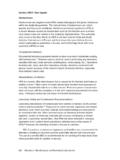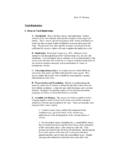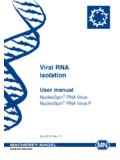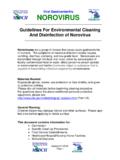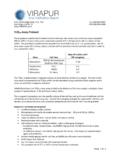Transcription of chapitre viral encephalopathy retinopathy - Home: …
1 2018 OIE - Manual of Diagnostic Tests for Aquatic Animals - 12/10/20181 CHAPTER ENCEPHALOPATHYAND RETINOPATHY1. Scope1 For the purpose of this chapter, viral encephalopathy and retinopathy (VER) otherwise known as viral nervous necrosis(VNN) is considered to be a serious disease of several marine fish species, characterised by significant lossesassociated to vacuolating lesions of the central nervous system and the Disease Agent Aetiological agent, agent strainsThe causative agent of VER or VNN was first identified as a new member of the family Nodaviridae followingpurification of brain tissues from affected striped jack larval, and the name striped jack nervous necrosis virus(SJNNV) was adopted (Mori et al., 1992). Subsequently other agents of VER/VNN were purified from somediseased fish species (Chi et al., 2001; Comps et al., 1994). The current taxonomy classifies the viruses intothe genus Betanodavirus within the family Nodaviridae (Schneemann et al.)
2 , 2005). Betanodaviruses arenon-enveloped, spherical and approximately 25 nm in diameter. The genome consists of two molecules ofpositive-sense ssRNA: RNA1 ( kb) encodes the replicase (110 kDa) and RNA2 ( kb) encodes the coatprotein (42 kDa). Complete nucleotide sequences of RNA1 and RNA2 were reported for SJNNV and others(Iwamoto et al., 2001; Iwamoto et al., 2004; Sommerset & Nerland, 2004; Tan et al., 2001). On the basis ofthe phylogenetic analysis of the T4 variable region of RNA1, betanodaviruses have been preliminarilyclustered into four major genotypes, designated: SJNNV-type, tiger puffer nervous necrosis virus(TPNNV)-type, barfin flounder nervous necrosis virus (BFNNV)-type, and red-spotted grouper nervousnecrosis virus (RGNNV)-type (Nishizawa et al., 1997). The identified genotypes partially correlate with threedifferent serotypes that have been identified by virus neutralisation with polyclonal antibodies, different hostspecies and the in vitro optimum growth temperature (Iwamoto et al.
3 , 2000; Mori et al., 2003). Furthermore,an additional genotype including a turbot betanodavirus strain (TNV) has been proposed (Johansen et al.,2004). To avoid confusion regarding the taxonomy, a numerical nomenclature (cluster I, II, III and IV),independent from the host species origin, has been proposed by Thi ry et al., 2004. In Table , the officialgenotypes, the target host species and the optimal in-vitro growth temperature are reported (Iwamoto et al.,2000). Survival outside the hostBetanodaviruses are highly resistant in the aquatic environment and can survive for a long time in sea waterat low temperatures (Frerichs et al., 2000) while at 25 C or higher, the survival rate is significantly of the aquatic environment following the appearance of an outbreak is likely to persist during1NB: Version adopted by the World Assembly of Delegates of the OIE in May 2013.
4 This disease is no longer listed by the Betanodavirus genotypic and phenotypic variantsGenotypeSerotypeTarget host fishOptimum growth temperatureSJNNVAS tripped jack20 25 CTPNNVBT iger puffer20 CBFNNVCCold-water fish: Atlantic halibut,Atlantic cod, flounders, 20 CRGNNVCWarm-water fish: Asian sea bass,European sea bass, groupers, 30 C22018 OIE - Manual of Diagnostic Tests for Aquatic Animals - 12/10/2018 Chapter - viral encephalopathy and retinopathylong periods and represent a source of infection for wild susceptible species. In frozen fish the virus maypersist for long periods and it may represent a potential risk if raw fish is used for feeding (Mori et al., 2005).Outside the aquatic environment, betanodaviruses seem to lose their cytopathogenicity very easily. In dryingconditions, >99% inactivation has been observed following a 7-day period at 21 C (Maltese & Bovo, 2007).
5 Stability of the agent (effective inactivation methods)Common disinfectants such as sodium hypochlorite, iodine, hydrogen peroxide, and benzalkonium chlorideare very useful for inactivating betanodaviruses while formalin shows a poor activity (Frerichs et al., 2000).Ozone has also been used to avoid or reduce virus contamination on egg shell surface (Grotmol & Totland,2000) and virus contaminated water may be effectively sterilised by UV exposure (Frerichs et al., 2000). Life cycleThe presence of reservoirs in the wild is very reasonably the original source of infection of farmed populationswhile the trade of infected juveniles represents the most common way to spread large amounts of virusparticles in the environment. Little is known about the life cycle of betanodaviruses. Considering the resultsobtained from experimental infections performed by different authors, the virus most likely invades the hostthrough the intestinal epithelium and peripheral nervous system, very soon reaching the central nervoustissues where it may induce the death of the host or remain for several years in survivors (Johansen et al.)
6 ,2004). Dead decomposed fish may spread the virus in the environment reaching different biological diseased fish may easily be cannibalised by predators who, besides the possibility of becominginfected, may spread the virus through contaminated faeces. Vertical transmission has been highly suspectedin some species (Arimoto et al., 1992; Comps et al., 1994; Grotmol & Totland, 2000; Mushiake et al., 1994;Watanabe et al., 2000); in this case virus may reach developing gonads where it has been frequently detected(Dalla Valle et al., 2000; Mushiake et al., 1994; Nishizawa et al., 1996) and infect the eggs and seminal fluids(Nishizawa et al., 1994). Host Susceptible host speciesTo date, the disease has been reported in more than 50 fish species, mainly marine with the greatest impactbeing in striped jack, European sea bass (Dicentrarchus labrax), groupers, and flatfishes (Munday et al.
7 ,2002; Sano et al., 2011). A few outbreaks have also been documented in freshwater farms (Bovo et al., 2011;Chi et al., 2003). Fish species naturally affected by VER are listed in Table ; other freshwater fish speciesdeveloped clinical signs following experimental infection (Furusawa et al., 2007) suggesting the possibility ofnew hosts, particularly in the future when new species will be selected for Fish species affected by VER/VNNO rderFamilyCommon nameLatin nameAcipenseriformesAcipenseridaeRussian sturgeon Acipenser gueldenstaedtiAnguilliformesAnguillidaeE uropean eel Anguilla anguillaGonorynchiformesChanidaemilkfish Chanos chanosSiluriformesSiluridaeChinese catfish Parasilurus asotusAustralian catfish Tandanus tandanusGadiformesGadidaeAtlantic cod Gadus morhuahaddock Melanogrammus aeglefinusCyprinodontiformesPoeciliidaeg uppy Poecilia reticulataPerciformesAcanthuridaeconvict surgeonfish Acanthurus triostegusApogonidaenarrowstripe cardinalfish Apogon exostigmaAnarhichadidaewolf fish Anarchichas minorChapter - viral encephalopathy and retinopathy2018 OIE - Manual of Diagnostic Tests for Aquatic Animals - 12/10/2018 3 PerciformesCarangidaestriped jack Pseudocaranx dentexpurplish amberjack Seriola
8 Dumeriliyellow-wax pompano Trachinotus falcatussnub nose pompano Trachinotus blochiiCentropomatidaeAsian sea bass Lates calcariferJapanese sea bass Lateolabrax japonicusCichlidaeTilapia Oreochromis niloticusEleotridaesleepy cod Oxyeleotris lineolataEphippidaeorbicular batfish Platax orbicularisLatridaestriped trumpeter Latris lineataLutjanidaecrimson snapper Lutjanus erythropterusmangrove red snapper Lutjanus argentimaculatusMalacanthidaeJapanese or red tilefish Branchiostegus japonicusMugilidaegrey mullet Mugil cephalusgolden grey mullet Liza auratared mullet Mullus barbatusOplegnathidaebarred knifejaw or rock bream Oplegnathus fasciatusspotted knifejaw Oplegnathus punctatusPercichthydaeEuropean sea bass Dicentrarchus labraxRachicentridaecobia Rachycentron canadumSciaenidaered drum Sciaenops ocellatusshi drum Umbrina cirrosawhite weakfish Atractoscion nobilisScombridaePacific bluefin tuna Thunnus orientalisSerranidaered spotted grouper E.
9 Akaarayellow grouper E. awoarasevenband grouper E. septemfasciatusblackspotted grouper E. fuscoguttatusbrown spotted grouper E. malabaricusdusky grouper E. marginatuskelp grouper E. moaragreasy grouper E. tauvinadragon grouper E. lanceolatushumpback grouper Chromileptes altiveliswhite grouper Epinephelus aeneusorange-spotted grouper E. coioidesTable Fish species affected by VER/VNNO rderFamilyCommon nameLatin name42018 OIE - Manual of Diagnostic Tests for Aquatic Animals - 12/10/2018 Chapter - viral encephalopathy and Susceptible stages of the hostAlthough the disease mainly affects the larval and juvenile stages, serious mortalities have been also reportedin market-size and adult fish, such as Atlantic halibut (Hippoglossus hippoglossus), sevenband grouper(Epinephelus septemfasciatus), and European sea Species or subpopulation predilection (probability of detection)In infected farms the probability of detecting the causal agent is normally higher in juveniles than in older fish,while during spawning season the virus may be found in the gonads of broodstock (Dalla Valle et al.)
10 , 2000;Mushiake et al., 1994). For this reason, surveillance programmes should include young fish as well asgonadal tissues, ovarian fluids and Target organs and infected tissueBrain, spinal cord and retina are considered the target organs in which the virus actively replicates causingextensive tissue vacuolation. Intracytoplasmic inclusions have been described in the brain cells of Europeansea bass, Asian sea bass (Lates calcarifer), Japanese parrotfish (Oplegnathus fasciatus), and brown-spottedgrouper (Epinephelus malabaricus) (Munday et al., 2002). The virus has been also detected in broodstockgonads (Dalla Valle et al., 2000; Mushiake et al., 1994; Nishizawa et al., 1996). In some species such asstriped jack, European sea bass, barfin flounder (Verasper moseri), sevenband grouper and Atlantic halibut,brood fish are likely to be the most consistent virus reservoir and the most important source of infection forlarvae and juvenile fish (Mushiake et al.











